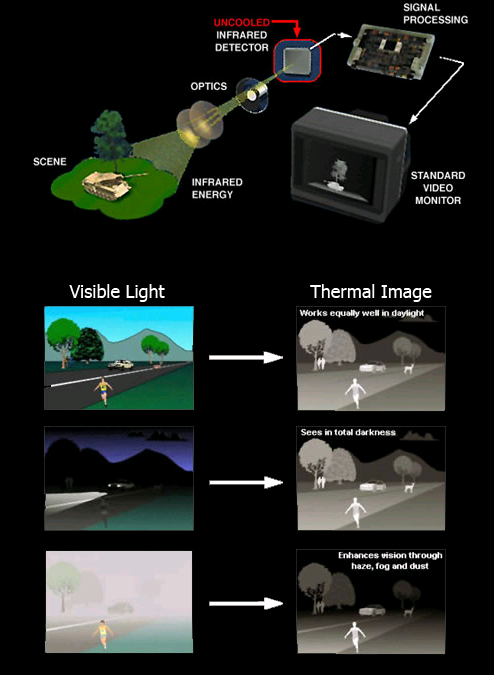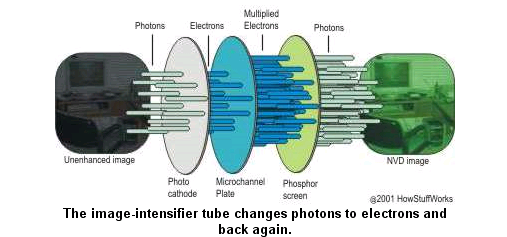Inventions that help humans see "more"


Unlike birds and insects, humans cannot see wavelengths outside of the range of 380 - 750 nm wavelengths. In fact, the definitions of ULTRAVIOLET and INFRARED, refer to the wavelengths stronger than (ultra) violet wavelengths, and weaker than (infra) red wavelengths. However, humans are trying to find ways to expand that visible range. As you can read in another section, avian and insectoid adaptations are primarily meant to help them see substances that emit at UV wavelengths.. For humans, right now, the primary advancement in increasing the range of visible wavelengths is in the range of infrared wavelengths. Thermal imaging and imaging enhancement equipment use the IR wavelengths to develop images so that, through the use of scopes, goggles and cameras, humans can see "in the dark".
IR equipment can "see" in the high end of the IR spectrum and the low end of the IR spectrum. In fact, because of the differences in the ranges perceived, the two types work in very different ways. The IR spectrum is split into Near-Infrared (as in Near to the Visible spectrum), Mid-Infrared, and Thermal-Infrared (also referred to as Far-Infrared). Their respective wavelength and energy ranges are the reasons that the IR equipment that operates in the lower end (Near-IR), functions differently from those that operate in the higher end (Far-IR). The wavelength ranges are as follows:
Near IR - .7 to 1.3 microns
Mid IR - 1.3 to 3 microns (this is the wavelength used in remote controls)
Far (Thermal) IR - 3 microns to 30+ microns
Infrared goggles and "nightvision" goggles fall into two primary categories.
- Image Enhancement - those that collect emissions in the Near IR spectrum and coelesce them into a perceivable image
- Heat Detection - those that detect emissions in the Far IR
spectrum, given off as heat from bodies that
are warmer than their surroundings (thus the name, Thermal IR)
These types of goggles are referred to as Infrared Goggles. While many will employ some type of image enhancement (see below), their primary purpose is to detect heat signatures and translate them into a recognizable image. It does this by doing the following:
1) A special lens gathers the image information of the targeted object.
2) This information is then transmitted to an infrared detector which then produces a thermogram, a picture of the heat patterns of the object(s).
3) This thermogram is then processed and developed into an image that is then transmitted to a monitor.

A common misconception about
thermal imaging is that it requires the subject being observed to be
hot, and that one could avoid detection simply by lowering the
temperature of the object. This is not true. Thermal
imaging senses a very high range of temperatures (-20 degrees C to 2000
degrees C). One might argue that putting the object at the same
temperature as its surroundings might be effective, but today's thermal
imaging equipment can sense a difference as small as .1 degree C, at a
distance of up to 300 meters.
There are two types of thermal imaging devices--Uncooled, and Cryogenically cooled. Uncooled devices work at room temperature, are battery-powered, and quiet. The drawback is that the images are not as clear and crisp. Cryogenically cooled devices have the drawback of being much less portable, due to size and a need for a power source. What they give up in convenience, they gain in detail, clarity and sensitivity. The device is sealed in a cryogenically cooled atmosphere to below 0 degrees C. This cooled atmosphere allows for a much higher level of performance, thus the greater detail and sensitivity.
There are two types of thermal imaging devices--Uncooled, and Cryogenically cooled. Uncooled devices work at room temperature, are battery-powered, and quiet. The drawback is that the images are not as clear and crisp. Cryogenically cooled devices have the drawback of being much less portable, due to size and a need for a power source. What they give up in convenience, they gain in detail, clarity and sensitivity. The device is sealed in a cryogenically cooled atmosphere to below 0 degrees C. This cooled atmosphere allows for a much higher level of performance, thus the greater detail and sensitivity.
Image Enhancement devices, also often called Night Vision Devices (NVDs), work at the opposite end of the IR spectrum from Thermal Imaging devices. The process is much more complicated, as well. Whereas Thermal Imaging devices just collect and translate heat emissions, NVDs convert photons into electrons, and then use the electrons to create images using phosphoresence.
Phosphorescent emissions occur when the electrons of a material are raised to an excited state, but then experience a spin change called intersystem crossing. This intersystem crossing allows the electrons to have a metastable state, a point at a higher energy level than the ground state, at which they stay before returning to the ground state. This metastable state allows for an emission that continues after the removal of the original energy source. NVDs take advantage of this delayed emission.

NVDs use phosphorescence by converting the photons of the incoming light into electrons, and using the electrons to develop and image on phosphorescent material. After the photons are converted to electrons, a device called a microchannel plate multiplies the number of electrons, in a process called cascaded secondary emission. In this process, like in fiber optics, the electrons are bounced around in a reflective tube. This ricocheting causes other electrons to be excited, which then in turn ricochet, causing other electrons to be excited. The result is that the number of electrons coming out the other side is vastly greater than what entered. This greatly increased number of electrons, still in the same formation as the photons that entered the system, is then shot at a phosphor-coated screen. The phosphorescent emissions then create an image which is seen through a lens. It is this reliance on phosphorescence that causes the signature green color of NVD images.
An informative and concise history of IR thermal imaging and image enhancement technologies can be found here.